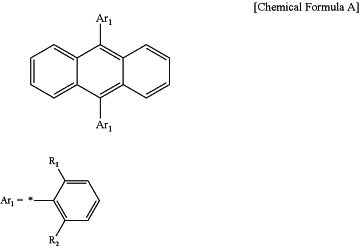| CPC H10K 85/615 (2023.02) [H10K 50/12 (2023.02)] | 7 Claims |
|
1. An organic light emitting diode, comprising:
a first electrode;
a second electrode facing the first electrode; and
a light emitting layer interposed between the first electrode and the second electrode,
wherein,
the light emitting layer includes a host and a dopant and at least one of the anthracene derivatives represented by the following Chemical Formula A is the host; and
the second triplet excited orbital energy level (T2) of the Chemical Formula A is higher than two times the lowest triplet excited orbital energy level (T1) (T2>2T1),
 wherein,
“*” within Ar1 denotes a bond to the carbon atom in the aromatic ring of the anthracene moiety, and
R1 and R2 are a substituted or unsubstituted heteroaryl of 2 to 20 carbon atoms,
wherein,
the substituents R1 and R2 are identical to each other, and
the term “substituted” in the expression “substituted or unsubstituted” means having at least one substituent selected from the group consisting of a deuterium atom, a cyano, a halogen, an alkyl of 1 to 10 carbon atoms, an aryl of 6 to 12 carbon atoms, and an arylalkyl of 6 to 12 carbon atoms.
|